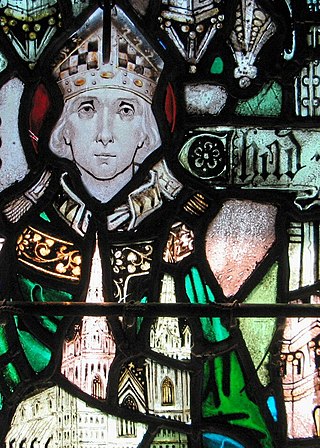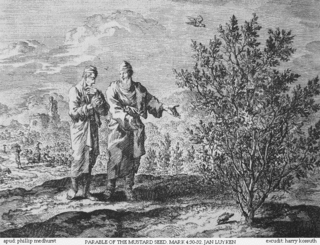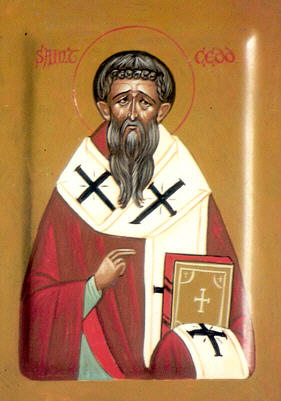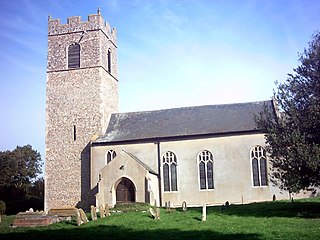
Palm Sunday is a Christian moveable feast that falls on the Sunday before Easter. The feast commemorates Christ's triumphal entry into Jerusalem, an event mentioned in each of the four canonical Gospels. Palm Sunday marks the first day of Holy Week. For adherents of mainstream Christianity, it is the last week of the Christian solemn season of Lent that precedes the arrival of Eastertide.

Gospel Oak is an inner urban area of north west London in the London Borough of Camden at the very south of Hampstead Heath. The neighbourhood is positioned between Hampstead to the north-west, Dartmouth Park to the north-east, Kentish Town to the south-east, and Belsize Park to the south-west. Gospel Oak lies across the NW5 and NW3 postcodes and is served by Gospel Oak station on the London Overground. The North London Suburb, Gospel Oak, has many schools around it.

Chad of Mercia was a prominent 7th-century Anglo-Saxon Catholic monk who became abbot of several monasteries, Bishop of the Northumbrians and subsequently Bishop of the Mercians and Lindsey People. He was later canonised as a saint.

Clare is a market town on the north bank of the River Stour in Suffolk, England. Clare is in southwest Suffolk, 14 miles (23 km) from Bury St Edmunds and 9 miles (14 km) from Sudbury. Clare won Village of the Year in 2010 and Anglia in Bloom award for Best Large Village 2011 for its floral displays in 2011. In March 2015, The Sunday Times and Zoopla placed Clare amongst the top 50 UK rural locations, having "period properties and rich history without the chocolate-box perfection – and the coach trips".

The Chapel of St Peter-on-the-Wall, Bradwell-on-Sea, is a Christian church dating from the years 660-662 and among the oldest largely intact churches in England. It is in regular use by the nearby Othona Community, in addition to Church of England services. It is a Grade I listed building

Cressage is a village and civil parish in Shropshire, England. It lies on the junction of the A458 and B4380 roads and the River Severn flows around its northern boundary. The Royal Mail postcode begins SY5. The parish council is combined with the neighbouring parish of Sheinton.

Greensted Church, in the small village of Greensted, near Chipping Ongar in Essex, England, has been claimed to be the oldest wooden church in the world, and probably the oldest wooden building in Europe still standing, albeit only in part, since few sections of its original wooden structure remain. The oak walls are often classified as remnants of a palisade church or, more loosely, as a kind of early stave church, dated either to the mid-9th or mid-11th century.

The Parable of the Mustard Seed is one of the shorter parables of Jesus. It appears in Matthew (13:31–32), Mark (4:30–32), and Luke (13:18–19). In the Gospels of Matthew and Luke, it is immediately followed by the Parable of the Leaven, which shares this parable's theme of the Kingdom of Heaven growing from small beginnings. It also appears in the non-canonical Gospel of Thomas.

Aldringham is a village in the Blything Hundred of Suffolk, England. The village is located 1 mile south of Leiston and 3 miles northwest of Aldeburgh close to the North Sea coast. The parish includes the coastal village of Thorpeness. The mid-2005 population estimate for Aldringham cum Thorpe parish was 730.

Cedd was an Anglo-Saxon monk and bishop from the Kingdom of Northumbria. He was an evangelist of the Middle Angles and East Saxons in England and a significant participant in the Synod of Whitby, a meeting which resolved important differences within the Church in England. He is venerated in the Catholic Church, Anglicanism, and the Orthodox Church.

Hartest is a small village and civil parish in the Babergh district of the English county of Suffolk. It is located halfway between Bury St. Edmunds and Sudbury on the B1066 road in the Glem valley. Brockley is two miles north.

The Epitaphios is a Christian religious icon, typically consisting of a large, embroidered and often richly adorned cloth, bearing an image of the dead body of Christ, often accompanied by his mother and other figures, following the Gospel account. It is used during the liturgical services of Good Friday and Holy Saturday in the Eastern Orthodox Churches and some Oriental Orthodox Churches as well as those Eastern Catholic Churches, which follow the Byzantine Rite. It also exists in painted or mosaic form, on wall or panel.

Polstead is a village and civil parish in the Babergh district of Suffolk, England. The village lies 3 miles (4.8 km) northeast of Nayland, 5 miles (8 km) southwest of Hadleigh and 9 miles (14 km) north of Colchester. It is situated on a small tributary stream of the River Stour.

Great Wratting is a village and civil parish in England, about four miles from Haverhill, Suffolk, in the valley of the River Stour. There is a ford across the Stour in the centre of the village, where bathing and fishing are common pursuits. The river here is heavily populated by crayfish, a non native species long since escaped from farms near the mouth of the Stour.
Roxton is a small village and civil parish in the Borough of Bedford, Bedfordshire, England about 7 miles (11 km) north-east of the county town of Bedford.

Chediston is a village and a civil parish on the B1123 road, in the East Suffolk district, in the English county of Suffolk. It is located 2 miles west of Halesworth, its post town. The population of the civil parish as of the 2011 census was 195 and in 2018 it was estimated to be 234.

St Peter and St Paul's Church, Lavenham is a Grade I listed parish church in the Church of England in Lavenham, Suffolk. It is a notable wool church and regarded as one of the finest examples of Late Perpendicular Gothic architecture in England.

St Mary's Church is a Grade I listed parish church in the Church of England in Stoke-by-Nayland.

The Church of St Mary, Lastingham, is the Anglican parish church for the village of Lastingham in North Yorkshire, England. The parish is part of Ryedale and is located 4 miles (6.4 km) north of Kirkbymoorside, 6 miles (9.7 km) west of Pickering and 30 miles (48 km) north east from York.

The Caton Oak was an ancient oak tree that stood in Caton, Lancashire, reputedly dating from the time of the druids. The oak tree stood atop a set of steps known as the "Fish Stones" that were used by medieval monks to display salmon for sale. The tree declined during the 20th century and was reinforced with a metal support; an acorn from the tree was planted in 2007 to grow a replacement. The original Caton Oak fell on 20 June 2016.



















